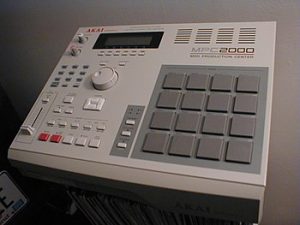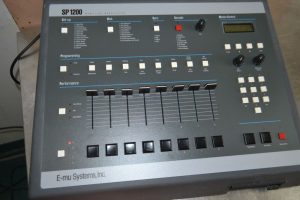

Digital Audio Workstations and Technological Rise in the Late 1980s/1990’s
The technological innovations of Digital Audio Workstations (DAWs) of the late 1980s and early 1990s revolutionized the performance and creation of hip hop. The SP 1200 (1987) and Akai MPC (1991) were two of the most breakthrough technologies that contributed to this change. These DAWs could record, edit, and playback audio recordings at the press of a button. Instead of having to master challenging techniques on turntables using various records, a DJ could press a button to play one sample or sound and then seamlessly transition to the next sound with the press of another button. The E-mu SP1200 and the Akai MPC-2000, allowed for sampling, drum programming, and sequencing all to be done within one machine, and the new drum samplers allowed producers to digitize drum beats from one record and add them to their sound banks for later use. This shifted the accreditation of an artist to go from being based on their physical turntabling techniques and mastery to being primarily focused on the sounds and mixtapes they created.
This technology innovation altered not only the difference in how to physically create the sounds but also changed how samples and recordings in music sounded. The ease of adding pre recorded sounds to a mix allowed artists to add sounds that were not exclusive to being in songs that had been recorded in the post. Hank Shocklee, in his lecture at the University of Richmond, described how he first thought to add every day sounds such as car alarms and street noises because he believed these sounds would help “cultivate the story” being conveyed through the music. Anthony Harrison’s article, Cheaper than a CD, Plus we really Mean it’ describes that both the SP 1200 and the Akai MPC samplers were capable of creating a sound that was representative of the ‘hip-hop sublime’, which couldbe defined as the “sonic sense of post-industrial hardness which results from combining ‘incommensurable musical layers’, dissonant harmonies, and clashing timbral qualities”.
Sampling via turntables and records typically featured longer portions of songs and was entirely instrumental. Sugarhill Gang’s “Rapper’s Delight” is an early hip hop song produced in 1979 that samples four songs, Chic’s “Good Times” being one of them. The sample of bass in the intro, according to whosampled.com, first appears at 0:18 and continues throughout the song. This sample comes from the bass riff of “Good Times” that first appears at time 3:12 in the song.
https://www.youtube.com/watch?v=tUqvPJ3cbUQ
The use of this sample in “Rapper’s Delight” sounds almost identical to its original recording: it has the same tempo and rhythm and is looped throughout the song.
The convenience of sampling through a DAW and the digital manipulation that can be used instead of replaying the sound exactly as it was recorded in its original, changed sampling in hip hop. Songs post DAW tended to use more samples and to manipulate the recordings. The Public Enemy song “What What” (1999) includes the “Funky Drummer”’s drum sample. The sample appears at time 0:03 and throughout the song, but may not be instantly recognizable to the listener. The sample is warped and manipulated, with a different tempo and extra beats that sound more like a synthesizer than a drum recording. The harsher, less melodic sound is representative of the sounds of hip hop after the late 1980’s.
The SP 1200 and Akai MPC-2000 not only altered the actual sounds of hip hop, but they also altered the community surrounding the genre, as explained by Madskillz and Hank Shocklee in their lecture at the University of Richmond. The price and skill required to own and operate turntables and mixers narrowed the demographic of people producing music to be highly talented people that could afford the large, expensive technology. The SP 1200 and Akai MPC-2000 were two of the first DAWs that eliminated these restrictions on who had access to producing and creating music. These DAWs were smaller, more affordable, and easier to use, opening the doors for any common person to now be able to create and produce music. The amount of music and the rate at which music was being produced rapidly increased, exponentially increasing the number of samples and amount of content being put into the hip hop community. Thanks to the new and accessible DAW technology of the late 1980s, many cities beyond just New York began to see the emergence of hip hop artists. In the years following the emergence of SP 1200 and Akai MPC, the pace of sampling began to increase rapidly and many ‘producers’ began to make names for themselves.
Watch 1:29 to 2:20
The hip hop genres of music were completely changed by the shift from turntables to digital audio workstations (DAWs), beginning with the SP 1200 and MPC-2000. Sampling became more convenient and significantly easier to execute. Through this, musicians were also afforded more creative leeway in their sampling technique. They were able to alter the sounds of samples to develop far beyond replaying the originally recorded sounds into being sampled more frequently and with less melodic, more harsh sounds. The collection of music and producers in the industry was no longer limited by a specific constraints due to economic status or previous musical experience. Hip-hop communities saw an exponential increase in size as a result of these technological advancements.